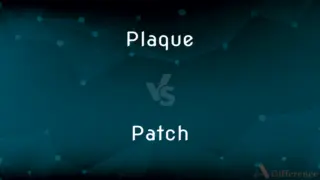Bannister vs. Baluster — What's the Difference?
By Fiza Rafique & Maham Liaqat — Updated on April 8, 2024
A bannister (or banister) refers to the handrail on the side of a staircase, while a baluster is a vertical moulding, spindle, or post that supports the handrail.

Difference Between Bannister and Baluster
Table of Contents
ADVERTISEMENT
Key Differences
A bannister, also known as a banister, is the term used for the handrail on a staircase. It serves as a support for people ascending or descending stairs, offering stability and safety. On the other hand, a baluster is a vertical post or spindle that forms part of the balustrade, the collective name for the row of balusters supporting the handrail.
While the bannister is what you hold onto, balusters are designed to prevent people from falling through the space between the handrail and the staircase itself. Balusters can be elaborately carved or simple posts, contributing to the staircase's aesthetic appeal. Conversely, the bannister is often designed with ergonomics in mind, ensuring a comfortable and secure grip.
In architectural terms, balusters are crucial for the structural integrity of a stairway's railing system, evenly spaced to create a barrier. Meanwhile, the bannister functions as the part of the stairway that users interact with most directly, enhancing the functionality and safety of the staircase.
The design and material of a bannister can vary widely, from wooden handrails to modern metal or glass, reflecting the overall style of the staircase and the surrounding space. In contrast, balusters offer an opportunity for decorative expression, with designs ranging from traditional turned wood to contemporary geometric shapes.
The distinction between a bannister and balusters underscores the balance between form and function in staircase design. While the bannister prioritizes user safety and comfort, balusters provide essential support and contribute to the staircase's visual appeal, demonstrating how individual components work together to create a cohesive and functional design.
ADVERTISEMENT
Comparison Chart
Definition
The handrail on the side of a staircase.
A vertical moulding, spindle, or post supporting the handrail.
Function
Provides stability and support for people using the stairs.
Prevents people from falling through the gap between the handrail and the steps.
Design Focus
Ergonomics and safety, with a comfortable grip for the hand.
Aesthetic appeal and structural support, with potential for decorative design.
Material Variety
Can be made of wood, metal, glass, or other materials, often matching or complementing the staircase.
Typically wood, metal, or stone, designed to match or contrast with the handrail and staircase style.
Placement
Runs along the top of the balusters, on one or both sides of the staircase.
Mounted vertically between the stair tread or floor and the handrail.
Compare with Definitions
Bannister
They ensure safety by providing something to hold onto.
Installing a sturdy bannister can make stairs safer for everyone.
Baluster
A baluster is a spindle or post supporting a staircase's handrail.
The carved wooden balusters added elegance to the grand staircase.
Bannister
A bannister is the handrail along a staircase for support.
She gripped the bannister tightly as she descended the steep stairs.
Baluster
Balusters prevent falls between the handrail and stairs.
The closely spaced balusters made the staircase safer for the children.
Bannister
It serves as a guide and support for stair users.
The old oak bannister added charm to the historic home's staircase.
Baluster
They form part of the balustrade system.
The glass balusters created a modern, transparent look for the staircase.
Bannister
The style of a bannister can vary to match decor.
We chose a wrought-iron bannister to match the house's Victorian theme.
Baluster
Their design can range from simple to intricate.
The staircase featured ornate balusters that reflected the building's historic significance.
Bannister
Bannisters can be a focal point of design.
The sleek, modern bannister was the centerpiece of the newly renovated entryway.
Baluster
Balusters contribute to the aesthetic of a staircase.
The metal balusters were designed to complement the contemporary style of the home.
Bannister
Variant of banister.
Baluster
A baluster is a vertical moulded shaft, square, or lathe-turned form found in stairways, parapets, and other architectural features. In furniture construction it is known as a spindle.
Bannister
Same as banister.
Baluster
A short decorative pillar forming part of a series supporting a rail or coping.
Bannister
English runner who in 1954 became the first person to run a mile in less than four minutes (born in 1929)
Baluster
One of the upright, usually rounded or vase-shaped supports of a balustrade.
Bannister
A railing at the side of a staircase or balcony to prevent people from falling
Baluster
An upright support, such as a furniture leg, having a similar shape.
Baluster
One of the supporting posts of a handrail.
Baluster
(architecture) A short column used in a group to support a rail, as commonly found on the side of a stairway; a banister. 17
Baluster
A small column or pilaster, used as a support to the rail of an open parapet, to guard the side of a staircase, or the front of a gallery. See Balustrade.
Baluster
One of a number of closely spaced supports for a railing
Common Curiosities
What is a bannister?
A bannister is the handrail on the side of a staircase, designed for support and safety.
What is a baluster?
A baluster is a vertical moulding, spindle, or post that supports the staircase's handrail.
Can a staircase have a bannister without balusters?
Typically, a bannister is supported by balusters or a similar structure to ensure safety and stability.
Are bannisters only used for safety?
While primarily for safety, bannisters also serve as a significant design element in a staircase.
How do balusters support a bannister?
Balusters are spaced evenly along the staircase to provide a stable base for the handrail.
Can balusters be decorative?
Yes, balusters often feature decorative designs, enhancing the staircase's aesthetic appeal.
How do I choose the right bannister and balusters for my staircase?
Consider the overall style of your space, safety requirements, and maintenance needs when selecting bannisters and balusters.
How are balusters attached to the staircase?
Balusters are typically attached to the steps or the base of the staircase and the underside of the handrail.
Do all staircases have bannisters?
Most staircases have bannisters for safety, but the design can vary widely.
What materials are used for bannisters and balusters?
Both can be made from a variety of materials, including wood, metal, and glass, depending on the design preferences.
Share Your Discovery

Previous Comparison
Plaque vs. Patch
Next Comparison
Abysmal vs. DismalAuthor Spotlight
Written by
Fiza RafiqueFiza Rafique is a skilled content writer at AskDifference.com, where she meticulously refines and enhances written pieces. Drawing from her vast editorial expertise, Fiza ensures clarity, accuracy, and precision in every article. Passionate about language, she continually seeks to elevate the quality of content for readers worldwide.
Co-written by
Maham Liaqat















































